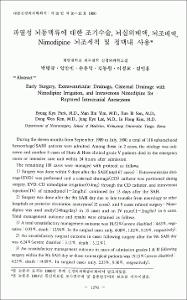KUMEL Repository
1. Journal Papers (연구논문)
1. School of Medicine (의과대학)
Dept. of Neurosurgery (신경외과학)
파열성 뇌동맥류에 대한 조기수술, 뇌실외배액, 뇌조배액, Nimodipine 뇌조세척 및 정맥내 사용
- Alternative Author(s)
- Yim, Man Bin; Son, Eun Ik; Kim, Dong Won; Lee, Jung Kyo; Kim, In Hong
- Journal Title
- 대한신경외과학회지
- ISSN
- 1225-8245
- Issued Date
- 1990
- Abstract
- During the eleven months from September, 1989 to July, 1990. a total of 118 subarachnoid hemorrhage(SAH) patients were admitted. Among these, in 2 cases, the etiology was unknown and another 8 cases of Hunt & Hess clinical grade Ⅴ patients died in the emergency room or intensive care unit within 24 hours after admission.
The remaining 108 cases were managed with protocol as follows.
1) Surgery was done within 9 days after the SAH(total 67 cases) : Extraventricular drainage(EVD) was performed and a cisternal drainage(CD) catheter was positioned during surgery. EVD, CD nimodipine irrigation(0.4㎎) through the CD catheter, and intravenous injection(Ⅳ) of nimodipine(l∼2㎎/hr) continued for 13 days after the SAH.
2) Surgery was done after the 9th SAH day due to late transfer from neurology or other hospitals or posterior circulation aneurysms(32 cases), and 9 cases refused surgery : Nimodipine was used orally(240㎎/day) in 35 cases and an Ⅳ route(l∼2㎎/hr) in 6 cases. Total management outcome and results were obtained as follows.
1) A total unsatisfactory management outcome was 18.52% (severe disabled : 4.63%, vegetative : 0.93%. death : 12.96%. In the surgical cases only, 4.08%, 1.02%, 9.19%, respectively).
2) An unsatisfactory surgical outcome in cases following surgery after the 9th SAH day was 6.24% (severe disabled : 3.12%, death : 3.12%).
3) An unsatisfactory management outcome in cases of admission grades Ⅰ& Ⅱ following surgery within the 9th SAH day or those non-surgical patients was 19.15% (severe disabled : 425%, death: 14.89%. In surgical cases only. 2.33%. 9.30%. respectively).
4) An unsatisfactory management outcome in cases of admission grade Ⅲ & Ⅳ with surgery within the 9th SAH day or non-surgical patients was 29.63% (severe disabled : 7.41 %, vegetative : 3.70%, death : 18.52%. In surgical cases only, 9.09%, 4.55%, 13.64%. respectively). One case of admission grade Ⅴ died.
5) Causes of unsatisfactory outcome were vasospasm : 9 cases(8.33%), SAH itself: 4 cases, rebleeding: 3 cases, surgical complication : 1 case, medical complication: 1 case, anesthesia : 1 case. and head trauma : 1 case.
6) Complications in management protocol with EVD. CD, CD nimodipine irrigation, and Ⅳ of nimodipine were transient hypotension(l case) and meningitis(5 cases). These complications were improved without sequelae with discontinuing the Ⅳ of nimodipine and using antibiotics.
We concluded that this protocol may improve the total management outcome of aneurysmal SAH patients, especially poor grade patients(Hunt & Hess grade Ⅲ & Ⅳ) without significant complications. However, in spite of this protocol, the leading cause of an unsatisfactory outcome is vasospasm.
- Alternative Title
- Early Surgery, Extraventricular Drainage, Cisternal Drainage with Nimodipine Irrigation, and Intravenous Nimodipine for Ruptured Intracranial Aneurysms
- Department
- Dept. of Neurosurgery (신경외과학)
- Publisher
- School of Medicine
- Citation
- 박병규 et al. (1990). 파열성 뇌동맥류에 대한 조기수술, 뇌실외배액, 뇌조배액, Nimodipine 뇌조세척 및 정맥내 사용. 대한신경외과학회지, 19(10~12), 1276–1285.
- Type
- Article
- ISSN
- 1225-8245
- Appears in Collections:
- 1. School of Medicine (의과대학) > Dept. of Neurosurgery (신경외과학)
- 파일 목록
-
-
Download
 oak-bbb-1614.pdf
기타 데이터 / 2.58 MB / Adobe PDF
oak-bbb-1614.pdf
기타 데이터 / 2.58 MB / Adobe PDF
-
Items in Repository are protected by copyright, with all rights reserved, unless otherwise indicated.